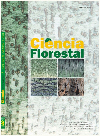
|
Ciência Florestal
Centro de Pesquisas Florestais - CEPEF, Departamento de Ciências Florestais - DCFL, Programa de Pós Graduação em Engenharia Florestal - PPGEF
ISSN: 0103-9954
EISSN: 0103-9954
Vol. 24, No. 3, 2014, pp. 759-770
|
 Bioline Code: cf14073
Bioline Code: cf14073
Full paper language: Portuguese
Document type: Review Article
Document available free of charge
|
|
|
Ciência Florestal, Vol. 24, No. 3, 2014, pp. 759-770
| pt |
ABORDAGEM SISTÊMICA E APLICAÇÃO DE RUGOSIDADES PARA DESENCADEAR PROPRIEDADES EMERGENTES EM RESTAURAÇÃO DE SOLOS DEGRADADOS
Aumond, Juarês José & de Maçaneiro, João Paulo
Resumo
Baseado na Teoria Geral dos Sistemas desenvolveu-se um modelo ecológico para a restauração dos
ecossistemas, cujos solos estejam muito degradados, tratando o ecossistema como um sistema dinâmico
complexo, hipersensível às condições iniciais de preparação do solo. Partindo da hipótese de que os
ecossistemas degradados são sensíveis às condições iniciais de preparação do solo, avaliou-se a técnica das
rugosidades (variações do relevo, alternando superfícies côncavas e convexas) para desencadear, ao longo
do tempo, propriedades emergentes que aceleram o processo de restauração ecológica. Os ecossistemas
degradados podem ser entendidos como sistemas organizacionalmente abertos, como uma estrutura
dissipativa, em que fluem matéria e energia, irreversivelmente. A principal tarefa, em restauração ecológica,
em áreas que tiveram o solo degradado consiste em obter a internalização da matéria e da energia para
induzir o sistema ao fechamento organizacional. As rugosidades, representadas pelas microtopografias do
solo, constituem uma técnica eficiente na internalização de matéria, retendo água, sedimentos, matéria
orgânica, nutrientes e sementes. As variações do relevo desencadeiam, ao longo do tempo, mudanças
ambientais de uma forma dinâmica e heterogênea que influenciam as interações entre a radiação solar, a
umidade e os nutrientes, criando oportunidades diferenciadas para as espécies vegetais e animais. Deve
haver uma concentração orientada para as estruturas de fluxos e de processos existentes entre o ecossistema
degradado (sistema) e o ambiente (vizinhança). Nessa abordagem dedica-se uma concentração especial nas
inter-relações entre o sistema degradado e o ambiente. Para restauração ecológica, cuja área esteja com solo
degradado, como a mineração e a pecuária, propõe-se uma nova abordagem sistêmica integradora na qual
as rugosidades do solo possam desencadear espacial e temporalmente, padrões e propriedades ambientais
emergentes devido à hipersensibilidade às condições iniciais de preparação do terreno.
Palavras-chave
restauração ecológica; pensamento sistêmico; internalização; microtopografias
|
| |
| en |
SYSTEMIC APPROACH AND ROUGHNESS APPLICATION TO CAUSE EMERGING PROPERTIES IN THE RESTORATION OF DEGRADED SOILS
Aumond, Juarês José & de Maçaneiro, João Paulo
Abstract
Based on the general systems theory, an ecological model for the restoration of ecosystems has been
developed, which soils are highly degraded, and treating the ecosystem as a complex dynamic system,
hyper-sensitive to initial conditions of soil preparation. Assuming that degraded ecosystems are sensitive to
initial conditions of soil preparation, the technique of roughness was evaluated (relief variations alternating
between concave and convex surfaces) to trigger over time emergent properties that accelerate the process
of ecological restoration. The degraded ecosystems can be understood as organizationally open systems, as
a dissipative structure, in which irreversibly matter and energy flow. The main task in ecological restoration
in areas that had the soil degraded is to achieve the internalization of matter and energy to induce the system
to organizational closure. The roughness, represented by soil micro-topography is an effective technique
in the internalization of matter, retaining water, sediment, organic matter, nutrients and seeds. Variations
of relief trigger environmental changes over time in a dynamic and heterogeneous way, which influence the interactions between solar radiation, moisture and nutrients, creating different opportunities for plants
and animal species. There must be an oriented concentration to flow structures and processes between
the degraded ecosystem (system) and the environment (neighborhood). In this approach, a particular
concentration on the interrelationships between the system and the environment is dedicated. For ecological
restoration, whose area is with degraded soil, such as mining and ranching, a new integrative degraded
systemic approach is proposed, in which the roughness of the soil might trigger spatial and temporal
patterns and emergent environmental properties due to the hyper-sensitivity to initial conditions of the land
preparation.
Keywords
ecological restoration; systems thinking; internalization; micro-topography
|
| |
© Copyright 2014 - Ciência Florestal
Alternative site location: http://cascavel.ufsm.br/revistas/ojs-2.2.2/index.php/cienciaflorestal/index
|
|
